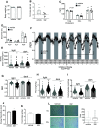A Synthetic ERR Agonist Alleviates Metabolic Syndrome
- PMID: 37739806
- PMCID: PMC10801787
- DOI: 10.1124/jpet.123.001733
A Synthetic ERR Agonist Alleviates Metabolic Syndrome
Abstract
Physical exercise induces physiologic adaptations and is effective at reducing the risk of premature death from all causes. Pharmacological exercise mimetics may be effective in the treatment of a range of diseases including obesity and metabolic syndrome. Previously, we described the development of SLU-PP-332, an agonist for the estrogen-related receptor (ERR)α, β, and γ nuclear receptors that activates an acute aerobic exercise program. Here we examine the effects of this exercise mimetic in mouse models of obesity and metabolic syndrome. Diet-induced obese or ob/ob mice were administered SLU-PP-332, and the effects on a range of metabolic parameters were assessed. SLU-PP-332 administration mimics exercise-induced benefits on whole-body metabolism in mice including increased energy expenditure and fatty acid oxidation. These effects were accompanied by decreased fat mass accumulation. Additionally, the ERR agonist effectively reduced obesity and improved insulin sensitivity in models of metabolic syndrome. Pharmacological activation of ERR may be an effective method to treat metabolic syndrome and obesity. SIGNIFICANCE STATEMENT: An estrogen receptor-related orphan receptor agonist, SLU-PP-332, with exercise mimetic activity, holds promise as a therapeutic to treat metabolic diseases by decreasing fat mass in mouse models of obesity.
Copyright © 2024 by The American Society for Pharmacology and Experimental Therapeutics.
Figures




Comment in
-
Conquering Metabolic Syndrome: Navigating Pharmacological Avenues for Comprehensive Therapeutics.J Pharmacol Exp Ther. 2024 Jan 17;388(2):229-231. doi: 10.1124/jpet.123.001908. J Pharmacol Exp Ther. 2024. PMID: 38233228 No abstract available.
References
-
- Alaynick WA, Kondo RP, Xie W, He W, Dufour CR, Downes M, Jonker JW, Giles W, Naviaux RK, Giguère V, et al. (2007) ERRgamma directs and maintains the transition to oxidative metabolism in the postnatal heart. Cell Metab 6:13–24. - PubMed
-
- Astorino TA, Schubert MM (2018) Changes in fat oxidation in response to various regimes of high intensity interval training (HIIT). Eur J Appl Physiol 118:51–63. - PubMed
Publication types
MeSH terms
Substances
Grants and funding
LinkOut - more resources
Full Text Sources
Medical
Miscellaneous
